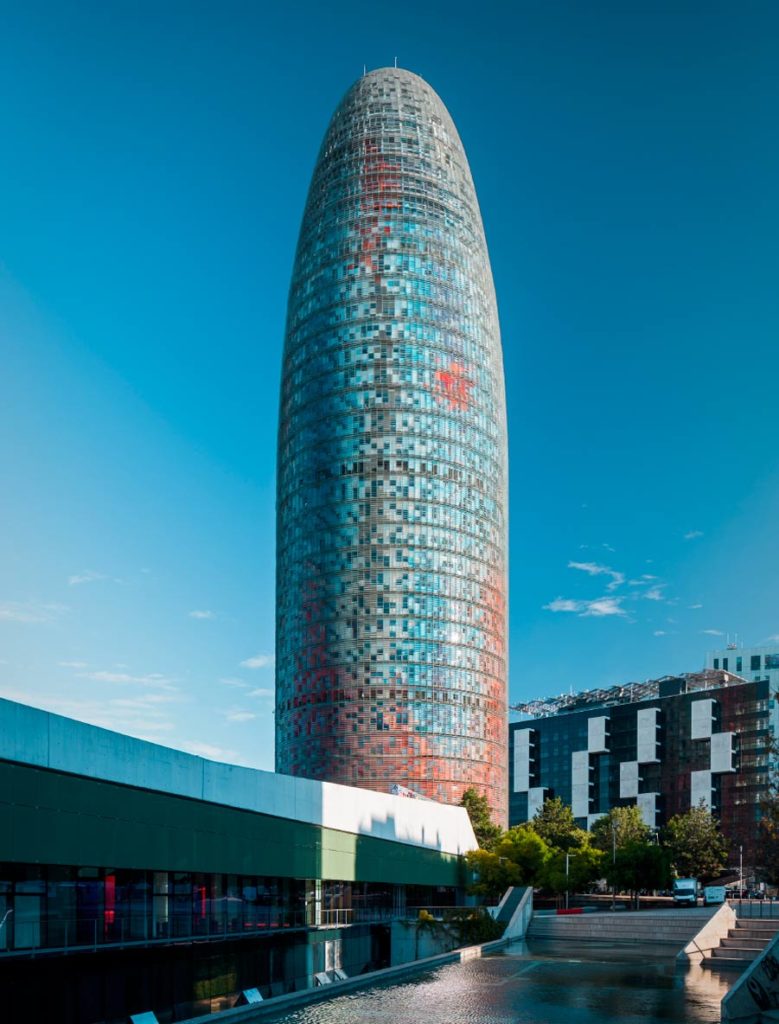Jean Nouvel, like Gaudí, was inspired by the rounded forms of the Montserrat mountains for the design of his great work in Barcelona. The first layer of Torre Glòries, which covers the concrete wall, is made up of aluminium sheets lacquered in 26 different colours in earth, red, blue, green and grey tones, which fade the higher they go. The second is formed by 52 744 transparent and translucent panes of glass. These layers evoke shiny smooth water, full of filtered light. It is a vibrant mirage in the distance. A symbol of Barcelona.
With a height of 144 metres, making it one of the highest buildings in Barcelona, it is like a geyser that rises from the ground and points to the sky with its glass dome. As such, it unfurls a transition of colours that represents the building’s temperature. At the bottom, warm colours predominate, a symbol of the magmatic, incandescent earth. Little by little, the water cools and makes the layers colder, with blue tones that become more predominant as the building gains height. Finally, the dome has no colour, it disappears visually, a symbol of the fusion with the ethereal, the air.
The ground plan of the tower is not round but oval. In fact, it is two ovals, one inside the other, two non-concentric cylinders crowned by a glass and steel dome. Inside, it has 30 open-plan floors with no interior pillars.
Since its inauguration on 16 September 2005, Torre Glòries, previously known as Torre Agbar, has become an icon of Barcelona. An efficient, avant-garde, high-tech building that is respectful of the city, designed and built by Jean Nouvel and b720 Arquitectos.


Torre Glòries is a living building without which it would be impossible to explain 21st-century Barcelona. It is a building that implements bioclimatic architecture, one that adapts to its surroundings, is sensitive to the impact it has on nature and minimises environmental pollution.
Aware that Barcelona has a mild climate, with high temperatures in summer, Jean Nouvel designed an intelligent air conditioning system, based on natural thermal insulation materials and ones with low heat transfer: concrete, aluminium and glass.
The architect’s commitment to sustainability is comprehensive. Other factors that contribute to this desire for energy efficiency include:


Jean Nouvel is one of the most famous and internationally renowned contemporary architects. He was born in a small town in France and during his childhood, he was forbidden two of his greatest passions: comics and film. As he himself says, this encouraged him to flout all the rules of the game, to hide books and sneak out to watch films. A rebelliousness that, in the future, would influence his way of understanding architecture.
Despite being one of the most innovative and controversial artists of recent times, Jean Nouvel didn’t grow up wanting to be an architect. His greatest passion is painting. His family allowed him to study Fine Arts provided that he also studied technical subjects. However, maths and physics were too complicated to mix with painting, leading him to architecture.
In the mid-1970s, Nouvel founded the French architectural movement known as Mars 1976. He also co-founded the Syndicat de l’Architecture. In 1989, the Aga Khan Foundation awarded him the Aga Khan Award for Architecture for the Arab World Institute in Paris. In 2000, he received a Golden Lion at the Venice Biennale of Architecture and a year later, in 2001, three of the highest international distinctions: the Royal Gold Medal by the Royal Institute of British Architects (RIBA), the Praemium Imperiale by the Japan Art Association and the Borromini Award for the Culture and Congress Centre in Lucerne. He became a doctor honoris causa of the Royal College of Art, London, in 2002. In 2008, he was awarded the prestigious Pritzker Prize. In France, he has also been awarded the Gold Medal by the Académie d’Architecture, two Équerre d’Argent and the Grand National Prize for Architecture.
Among his most famous works are the Arab World Institute in Paris, the renovation of the Lyon Opera House, the Tours Convention Centre, the Cartier Foundation in Paris and the Culture and Congress Centre in Lucerne.



